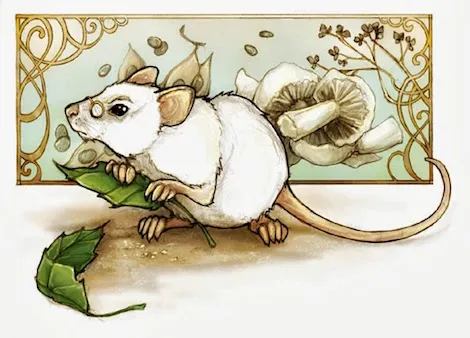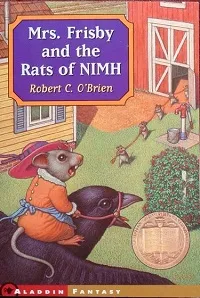
Mrs. Frisby and the Rats of NIMH: A Book for the Resistance
This content contains affiliate links. When you buy through these links, we may earn an affiliate commission.
I first read Mrs. Frisby and the Rats of NIMH in elementary school in the ’70s. It completely captured my heart and inspired a lifelong love affair with fiction. I read the book several times over the years, happily introducing it to my children when they were little. Over a decade since my last time through this beloved book, I recently decided to revisit it, curious to see if it still held the same magic I remembered from my youth.
 The story follows Mrs. Frisby, a widowed field mouse with four children. The family must move out of their winter home in the garden before farmer Fitzgibbon comes with his plow, but the youngest son Timothy is gravely ill and cannot survive the trek to the meadow. In desperation, the mother mouse seeks help, first from a wise old owl, and then from the mysterious Rats of NIMH, a community of super intelligent rodents that live under the rosebush on the farm.
Originally published in 1971, Robert C. O’Brien’s Newbery Award–winning book was every bit as clever and enchanting as I remembered. But my reading this time held new lessons for me. In light of the widening ideological gulf in our country, the surge in hate crimes against minorities, and the current administration’s unwelcoming policies towards immigrants, reading Mrs. Frisby and the Rats of NIMH turned out to be so much more than a trip down memory lane. In the context of our nation’s current tensions, it presented itself as an ideal story for the Resistance.
I started reading the book in June, just as news was emerging that hundreds of immigrant families were being separated at the Mexican border following the “zero tolerance” policy enacted by the current administration. I remember seeing reports of parents who had made the treacherous journey, seeking asylum to escape from danger in their home countries, only to be further traumatized by having their children taken away upon arrival. I was heartbroken and angry and could not stop thinking of those terrified families.
Later that night, as I returned to my book, I came across this passage and was struck by the uncanny similarity:
The story follows Mrs. Frisby, a widowed field mouse with four children. The family must move out of their winter home in the garden before farmer Fitzgibbon comes with his plow, but the youngest son Timothy is gravely ill and cannot survive the trek to the meadow. In desperation, the mother mouse seeks help, first from a wise old owl, and then from the mysterious Rats of NIMH, a community of super intelligent rodents that live under the rosebush on the farm.
Originally published in 1971, Robert C. O’Brien’s Newbery Award–winning book was every bit as clever and enchanting as I remembered. But my reading this time held new lessons for me. In light of the widening ideological gulf in our country, the surge in hate crimes against minorities, and the current administration’s unwelcoming policies towards immigrants, reading Mrs. Frisby and the Rats of NIMH turned out to be so much more than a trip down memory lane. In the context of our nation’s current tensions, it presented itself as an ideal story for the Resistance.
I started reading the book in June, just as news was emerging that hundreds of immigrant families were being separated at the Mexican border following the “zero tolerance” policy enacted by the current administration. I remember seeing reports of parents who had made the treacherous journey, seeking asylum to escape from danger in their home countries, only to be further traumatized by having their children taken away upon arrival. I was heartbroken and angry and could not stop thinking of those terrified families.
Later that night, as I returned to my book, I came across this passage and was struck by the uncanny similarity:
 The story follows Mrs. Frisby, a widowed field mouse with four children. The family must move out of their winter home in the garden before farmer Fitzgibbon comes with his plow, but the youngest son Timothy is gravely ill and cannot survive the trek to the meadow. In desperation, the mother mouse seeks help, first from a wise old owl, and then from the mysterious Rats of NIMH, a community of super intelligent rodents that live under the rosebush on the farm.
Originally published in 1971, Robert C. O’Brien’s Newbery Award–winning book was every bit as clever and enchanting as I remembered. But my reading this time held new lessons for me. In light of the widening ideological gulf in our country, the surge in hate crimes against minorities, and the current administration’s unwelcoming policies towards immigrants, reading Mrs. Frisby and the Rats of NIMH turned out to be so much more than a trip down memory lane. In the context of our nation’s current tensions, it presented itself as an ideal story for the Resistance.
I started reading the book in June, just as news was emerging that hundreds of immigrant families were being separated at the Mexican border following the “zero tolerance” policy enacted by the current administration. I remember seeing reports of parents who had made the treacherous journey, seeking asylum to escape from danger in their home countries, only to be further traumatized by having their children taken away upon arrival. I was heartbroken and angry and could not stop thinking of those terrified families.
Later that night, as I returned to my book, I came across this passage and was struck by the uncanny similarity:
The story follows Mrs. Frisby, a widowed field mouse with four children. The family must move out of their winter home in the garden before farmer Fitzgibbon comes with his plow, but the youngest son Timothy is gravely ill and cannot survive the trek to the meadow. In desperation, the mother mouse seeks help, first from a wise old owl, and then from the mysterious Rats of NIMH, a community of super intelligent rodents that live under the rosebush on the farm.
Originally published in 1971, Robert C. O’Brien’s Newbery Award–winning book was every bit as clever and enchanting as I remembered. But my reading this time held new lessons for me. In light of the widening ideological gulf in our country, the surge in hate crimes against minorities, and the current administration’s unwelcoming policies towards immigrants, reading Mrs. Frisby and the Rats of NIMH turned out to be so much more than a trip down memory lane. In the context of our nation’s current tensions, it presented itself as an ideal story for the Resistance.
I started reading the book in June, just as news was emerging that hundreds of immigrant families were being separated at the Mexican border following the “zero tolerance” policy enacted by the current administration. I remember seeing reports of parents who had made the treacherous journey, seeking asylum to escape from danger in their home countries, only to be further traumatized by having their children taken away upon arrival. I was heartbroken and angry and could not stop thinking of those terrified families.
Later that night, as I returned to my book, I came across this passage and was struck by the uncanny similarity:
Mrs. Frisby was afraid. Then she thought of Timothy, and of the big steel plow blade. She told herself: I have no choice. If there is any chance the owl might be able to help me, to advise me, I must go.
Just like those desperate parents I had just read about in the news, Mrs. Frisby is risking all for the chance to save her child and keep her family together. She approaches the owl in need of mercy and assistance, and unlike the families at our border, Mrs. Frisby is granted the hope that help is possible. The owl tells her to go to the Rats of NIMH. Mrs. Frisby is afraid to approach the Rats. She has seen them of course, but has never interacted with their kind, and doesn’t know what to expect. The Rats have lived as an isolated community, often misunderstood and maligned by other animals and humans. But having nowhere else to turn, she reaches out for help. To her surprise, the Rats of NIMH are welcoming and gracious, and once she takes the time to learn about them, she comes to have great respect for their resourcefulness and kindness. Over and over, we see characters that could easily be enemies choosing instead to join forces and work together. The very traits that make them so different from one another are often the most helpful. Where one animal is lacking, another steps forward to supply a unique solution that only they can contribute. Mrs. Frisby cannot save her son alone. She is dependent on the abilities and generosity of those outside her usual circle. The story demonstrates beautifully how disparate groups can enjoy and benefit from the natural diversity within a community when they are all striving together for the common good. The farmyard society has one especially dangerous threat: Dragon, the farmer’s cat. It is amazing to see how the animals come together to safeguard against this threat to the safety of their community. Instead of considering their own welfare first, the common refrain is, “We all help one another against the cat.” At a time when treasured freedoms are under attack, when the most vulnerable among us are left at risk, it was good to be reminded that we have great power when we stand united to help our fellow humans. Like all great literature, this cherished classic carries a message that has endured long after the time in which it was written. The compelling themes that run through this story—compassion for the suffering, protection for the defenseless, unity within diversity—helped fuel my resolve to keep resisting the injustice, ignorance, and cruelty I am seeing in these difficult days. I hope that teachers will put Mrs. Frisby in the hands of their young students, that parents will share the story with their children, and that this stirring tale of empathy and courage continues to find new readers in the years to come. We need Mrs. Frisby now more than ever.








